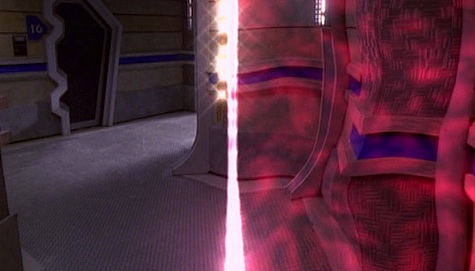The pervasively magical stories of Neil Gaiman are everywhere these days, which often makes us wonder if hundreds of years from now he won’t be regarded in mythical, legendary tones, like Hans Christian Andersen, or the Grimm Brothers. Just like those guys, Neil Gaiman was inspired by existing stories, too, but interestingly enough, when Gaiman plays in other sandboxes, he frequently employs a kind of “bubble universe” where his unique sensibilities are free to roam, relatively unconstrained by the rules of the world he’s visiting.
Here are four instances of Gaiman setting up shop in a familiar world and making it his own.

Sherlock Holmes/H.P. Lovecraft: “A Study in Emerald”
In this very early Neil Gaiman short story, H.P. Lovecraft collides with Sir Arthur Conan Doyle in a tricky reimagined version of the first Sherlock Holmes novel, A Study in Scarlet. The primary ingredient is the setting of the tale: an alternate Victorian England ruled by the many-tentacled Cthulhu and, I must admit, the main twist of this story fooled me when I first read it several years ago. I believed the narrator to be a bizarro-world John Watson, but in fact, it’s subtly written by Sebastian Moran and concerns him and Moriarty.
Here, John Watson and a thinly disguised Sherlock Holmes are villains, and Moran and Moriarty are the good guys. “A Study in Emerald” is packed with nerdy inside references to Conan Doyle’s stories even as it recasts the Sherlock Holmes universe with unspeakable monsters. This particular story is also fascinating not only because of the mash-up of story elements, but because Gaiman makes an effort to write the tale in the prose style of both Conan Doyle and Lovecraft. Though thoroughly Gaiman-esque, this story doesn’t sound like Gaiman. In this case that was entirely the point, as the author admits in the introduction to the story in his short fiction collection Smoke and Mirrors. Although Gaiman also states that he was not entirely satisfied that he successfully hid his voice or accomplished a true mingling of the Lovecraft and Conan Doyle mythos. Gaiman’s efforts in other universes are arguably more Gaiman-esque. Perhaps his lack of satisfaction with “A Study in Emerald” is the culprit? (Download it for free on Neil Gaiman’s site.)

Babylon 5: “Day of the Dead”
With devoted fans and a crazy prolific writer/creator in the form of J. Michael Straczynski, Babylon 5 is often spoken about in reverent tones and praised for being “real” science fiction for television. By its fifth and final season, Straczynski was writing every single episode, so it seems strange that Neil Gaiman would pen an episode of the show, especially since the author is not exactly known for the hard science fiction that defines Babylon 5.
Odder still is that Gaiman’s episode debuted while the show was neck-deep in its ongoing story arcs. “Day of the Dead” gets around this by literally severing a piece of the station and sending it elsewhere so that the characters can experience the events of the episode without affecting the ongoing plot.
In this episode, a section of Babylon 5 is sent to the homeworld of an alien race called the Brakiri, who are celebrating a religious holiday. This special night involves the return of those long dead, turning B5 into ghostville as people who had died previously on the show came back to have chats with those still alive.
Gaiman walks an interesting line here, because while some of this is continuity porn, it’s mostly just exploring the notion of being able to gab with someone who is back from the dead for one night. In fact, Gaiman’s writing is best showcased when characters are talking with ghosts who have absolutely no bearing on the larger storyline of the show. Captain Lochley (a new character to B5 at that point) gets the best storyline of all, as she tries to make peace with what is essentially the ghost of her college roommate. Darker still, this roommate had committed suicide, and Captain Lochley still harbors guilt over the whole thing. Here, a really, really great character piece plays out like a cathartic short story, and somehow it’s smack dab in the middle of a science fiction epic. Gaiman navigates these very personal and touching spooky tales expertly, as you’d imagine he would, but by the end of the episode you still feel like you’ve taken a bit of a break from the show itself. You’re dreaming now, but don’t worry, you’ll have woken up by the next episode.
1602
In the early 2000s Marvel Comics practically burst out of its skin proclaiming that Neil Gaiman was writing something in their comics universe, and reader anticipation for the project was high, helped by the fact that Marvel refused to reveal what characters would be involved or what the story would be about.
The eight-issue mini-series 1602 would turn out to be the entire Marvel Universe As Imagined By Neil Gaiman. Rather than work with existing continuity, Gaiman took the established characters and imagined how existing circumstances at the dawn of the 17th century would bring them about. His interpretation, full of grand setpieces, high drama, a touch of the eldritch, and a fair bit of swashbuckle, would prove so popular that Marvel continued to tell tales in this alternate timeline for years afterwards. Near the end of Gaiman’s mini-series, the books themselves comment on the fact that they’re a bubble universe within a larger one.
Gaiman would return to play in the established Marvel universe a couple years later with a mini-series that re-established Jack Kirby’s Eternals characters and folded them back into the ongoing Marvel Comics universe. As opposed to the runaway success of 1602, the results of The Eternals were mixed, and the characters and elements that he introduced were barely ever heard from again.
Which begs the question of whether it’s even possible for Neil Gaiman to become part of a larger universe while asserting his unique style. With The Eternals, Gaiman’s attempts to conform to a specific continuity were rejected by readers already accustomed to it, which prompts the question: Should he have even tried in the first place?

Doctor Who: “The Doctor’s Wife”
Full of patchwork people and doll-like entities, “The Doctor’s Wife” feels like Neil Gaiman right off the bat. The Doctor, Amy, Rory, and the TARDIS even immediately travel to “a bubble universe” so the events of the episode can play out.
There’s a lot of fun sci-fi concepts in this one, particularly the notion that there is an interdimensional Bermuda triangle filled with lost spaceships. Despite wide vistas of a starship graveyard, Gaiman gives the episode a fairy tale quality, going so far as to personify the Doctor’s beloved TARDIS as a sci-fi fairy creature.
What’s notable about this, however, is that Gaiman’s personal style works extremely well within the parameters of the show. (Especially Moffat’s particular brand of Doctor Who, which delights in careening between dreamy fairy tales and manic sci-fi.) By personifying the Doctor’s space/time machine as the delightful Idris, Neil Gaiman changes Doctor Who forever while also staying true to its spirit. When Idris joyously yells “THIEF!!!” at the start of the episode, you know this is a Gaiman character through and through. (Shades of Delirium from Sandman?) And when Amy and Rory are trapped in the TARDIS by House, Gaiman’s particular brand of unseen horror seeps through.
But what’s really going on in this episode is what makes it great: a time traveler gets to meet his time machine as a living person. Again, it’s a personal story, about two people who wouldn’t normally meet, able to actually interact through what is basically magic. There’s something really classic about this premise, and considering how often Gaiman has reinterpreted classic stories, it comes as no surprise that the author would choose to do the same in Doctor Who.
In a way, this episode exists as self-commentary on the fact that Gaiman creates his own space within existing franchises and universes. Doctor Who is a very stretchable show, encompassing a variety of genres, and Gaiman didn’t literally have to take the characters into an entirely new universe to tell the story of “The Doctor’s Wife.” In a funny twist, though, the story works as well as it does because he did. We learned a great deal about the Eleventh Doctor and how he feels about his people. We learned even more about the TARDIS, how it makes decisions, its history, and how it feels about the Doctor (“my thief”). We learned just how deep Rory’s resentment towards Amy’s ambivalence goes. And it all happens during a high stakes race to prevent House from entering the “real” universe.
Gaiman had to do what he does best, take the show outside of itself, in order for us to learn more about its characters and concepts, which is an amazing trick to pull off. One wonders what we’re in for in his forthcoming episode, “Nightmare in Silver.”
These aren’t the only instances of Neil Gaiman creating his own universe inside of others. Sandman is the most obvious example, and you can make the argument that he did the same in his work on Miracleman, Batman, in songwriting projects that he’s been a part of, and in other worlds that he’s dipped into.
What’s intriguing is how well-suited Gaiman’s plots, themes, and style of prose are to this kind of storytelling. Most any other writer attempting the same would be jarring, or uncomfortable, but not Gaiman, despite the fact that the author’s style is readily apparent in his own universes or in others.
How does that work?
Ryan Britt is a longtime contributor to Tor.com.
Chris Lough is the production manager of Tor.com and is pretty sure his freshmen and sophomore year of high school were written by Neil Gaiman.











I can’t bring myself to complain, because he does it so well!
But great post. Right on the money!
One of my favorites of Neil Gaiman working in someone else’s universe is the short story “Snow, Glass, Apples”. I’ve never been able to look at the Snow White story in the same way after reading this one. For as many different spins on this tale that have come out recently (Snow White and the Huntsman; Mirror, Mirror), none of them even come close to rising to the level that Gaiman reaches.
I find it totally hilarious that you call ‘A Study In Emerald’ one of his early short stories…is it really or am I just that old? Anyway, this might not really fit in with what you have here but another ‘playgound’ Neil played in the past that I really enjoyed was his biography of Douglas Adams (it was written in the style of Douglas Adams!). One wonders I his long out of print biography of Duran Duran is in the style of 80’s new wave pop…
PS: I watch his B5 episode every November 1st…it’s one of my favourite traditions.
@3. catterpillarboy. I can personally confirm that the Duran Duran bio is sadly not in the style of 80s New Wave pop. :)
I’m not too familiar with Neil Gaiman. Right now I’m reading Sandman for the first time and the Miracleman comics he took over after Alan Moore quit the series. The Sandman is good. Miracleman, not so much.
@3, amen. I already owned two Gaiman short story collections before that story was published. I think I’d been reading him for about 13 years at that point…
‘A Study in Emerald’ was written seventeen years after his first story, a Cthulu mythos story whose title you should look up, was written in 1987. So no, it’s not one of his early stories.
“Should he have even tried in the first place?”
Yes, always. Always try. Make new mistakes.
You left out the DC universe, which Sandman is set in (or perhaps given the scope of Sandman, it would be more fair to say that the DC universe is set in Sandman).
Thanks for the surprise spoilers right off the bat. :(
Gee, a great post and an excellent insight. I would like to say something else but, actually, additional comments would be redundant.
All I can say is: Neil Gaiman is a genius. Period.
My first exposure to Gaiman was the B5 script, which I thought was wonderful. He really got in the heads of the characters with those ghost stories, and while the episode didn’t move the plot arc for the series, it brought us a richer understanding of the world and characters. I later heard him do a reading at a WorldCon, and raved about what a great story teller he was. And at the end of the Con, my son presented me with a copy of the B5 script, that he had gotten autographed by Gaiman for me. How’s that for a great son?
Oh, dear me- how could I forget “I, Cthulhu, or, What’s A Tentacle-Faced Thing Like Me Doing In A Sunken City Like This (Latitude 47° 9′ S, Longitude 126° 43′ W)?” which could be found on this very website? As much as I enjoyed ‘A Study in Emerald’ this is THE Neil-Gaiman-Playing-In-Lovecraft story!
It wasn’t that big a deal that Gaiman imagined the “entire” Marvel universe. That happens fairly often. In the past decade or so, they’ve had the “Powerless” and “Noir” continuities that examined the heroes appearing in timelines that don’t have explicit powers, as well as alternate universes like Ultimate and Marvel Zombies. Some of those were runaway successes. The only one that had fewer follow-up miniseries than 1602 was Powerless. I know I’m forgetting some others – can anyone help?
1602 wasn’t a huge success as far as ongoing properties go (though I’m sure Gaiman’s issues sold very well). I also didn’t find it that interesting as a story on its own. Yes, he put more care and interesting ideas into it than most of the spin-off universes did, but it was mostly slow build-up without much payoff.